display LINCOLN MKZ 2014 Repair Manual
[x] Cancel search | Manufacturer: LINCOLN, Model Year: 2014, Model line: MKZ, Model: LINCOLN MKZ 2014Pages: 468, PDF Size: 4.49 MB
Page 172 of 468
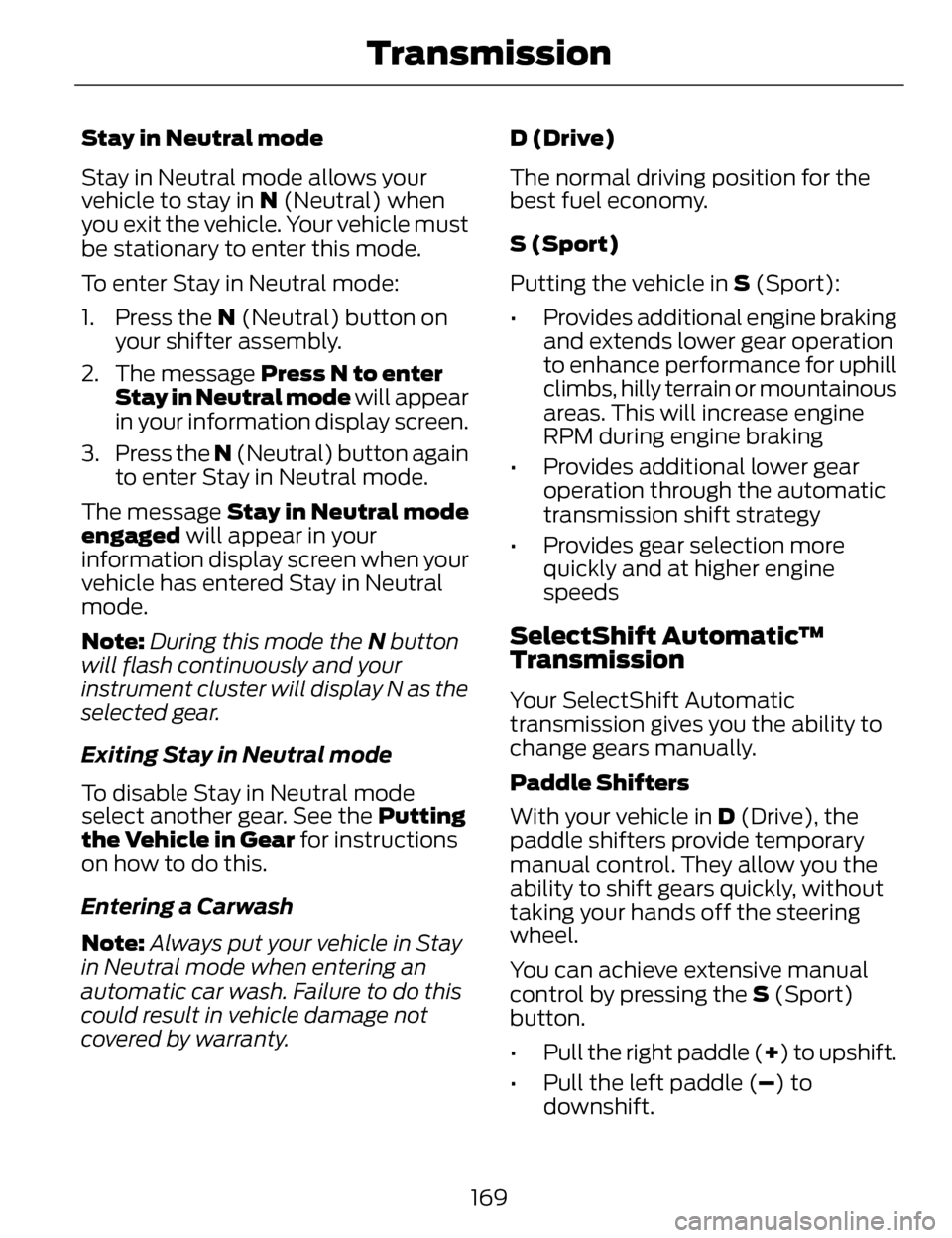
Stay in Neutral mode
Stay in Neutral mode allows your
vehicle to stay in N (Neutral) when
you exit the vehicle. Your vehicle must
be stationary to enter this mode.
To enter Stay in Neutral mode:
1. Press the N (Neutral) button onyour shifter assembly.
2. The message Press N to enter Stay in Neutral mode will appear
in your information display screen.
3. Press the N (Neutral) button again
to enter Stay in Neutral mode.
The message Stay in Neutral mode
engaged will appear in your
information display screen when your
vehicle has entered Stay in Neutral
mode.
Note: During this mode the N button
will flash continuously and your
instrument cluster will display N as the
selected gear.
Exiting Stay in Neutral mode
To disable Stay in Neutral mode
select another gear. See the Putting
the Vehicle in Gear for instructions
on how to do this.
Entering a Carwash
Note: Always put your vehicle in Stay
in Neutral mode when entering an
automatic car wash. Failure to do this
could result in vehicle damage not
covered by warranty. D (Drive)
The normal driving position for the
best fuel economy.
S (Sport)
Putting the vehicle in S (Sport):
• Provides additional engine braking
and extends lower gear operation
to enhance performance for uphill
climbs, hilly terrain or mountainous
areas. This will increase engine
RPM during engine braking
• Provides additional lower gear operation through the automatic
transmission shift strategy
• Provides gear selection more quickly and at higher engine
speeds
SelectShift Automatic™
Transmission
Your SelectShift Automatic
transmission gives you the ability to
change gears manually.
Paddle Shifters
With your vehicle in D (Drive), the
paddle shifters provide temporary
manual control. They allow you the
ability to shift gears quickly, without
taking your hands off the steering
wheel.
You can achieve extensive manual
control by pressing the S (Sport)
button.
• Pull the right paddle ( +) to upshift.
• Pull the left paddle ( –) to
downshift.
169
Transmission
Page 173 of 468
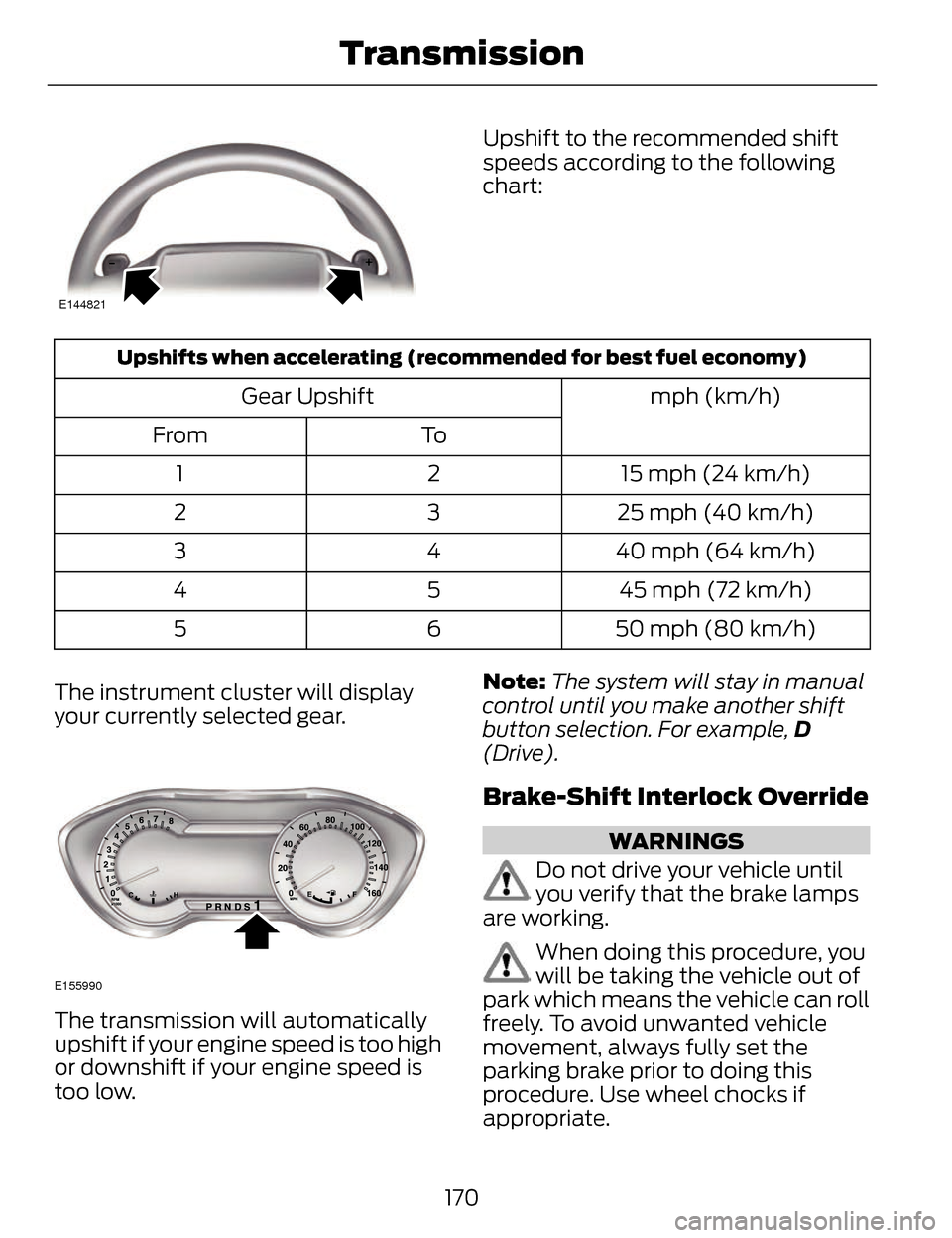
E144821
Upshift to the recommended shift
speeds according to the following
chart:
Upshifts when accelerating (recommended for best fuel economy)
mph (km/h)
Gear Upshift
To
From
15 mph (24 km/h)
2
1
25 mph (40 km/h)
3
2
40 mph (64 km/h)
4
3
45 mph (72 km/h)
5
4
50 mph (80 km/h)
6
5
The instrument cluster will display
your currently selected gear.
E155990
The transmission will automatically
upshift if your engine speed is too high
or downshift if your engine speed is
too low. Note:
The system will stay in manual
control until you make another shift
button selection. For example, D
(Drive).
Brake-Shift Interlock Override
WARNINGS
Do not drive your vehicle until
you verify that the brake lamps
are working.
When doing this procedure, you
will be taking the vehicle out of
park which means the vehicle can roll
freely. To avoid unwanted vehicle
movement, always fully set the
parking brake prior to doing this
procedure. Use wheel chocks if
appropriate.
170
Transmission
Page 176 of 468
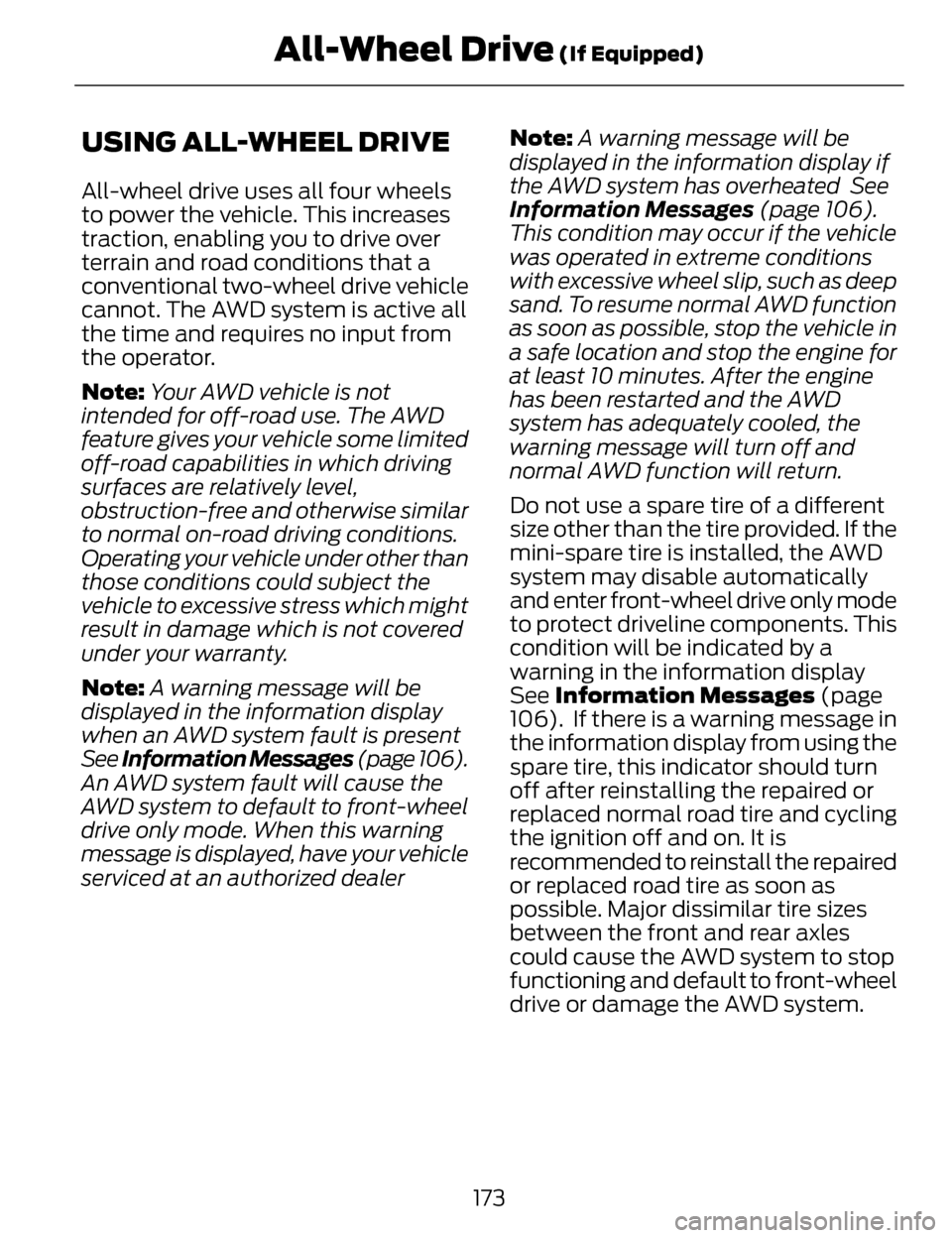
USING ALL-WHEEL DRIVE
All-wheel drive uses all four wheels
to power the vehicle. This increases
traction, enabling you to drive over
terrain and road conditions that a
conventional two-wheel drive vehicle
cannot. The AWD system is active all
the time and requires no input from
the operator.
Note:Your AWD vehicle is not
intended for off-road use. The AWD
feature gives your vehicle some limited
off-road capabilities in which driving
surfaces are relatively level,
obstruction-free and otherwise similar
to normal on-road driving conditions.
Operating your vehicle under other than
those conditions could subject the
vehicle to excessive stress which might
result in damage which is not covered
under your warranty.
Note: A warning message will be
displayed in the information display
when an AWD system fault is present
See Information Messages (page 106).
An AWD system fault will cause the
AWD system to default to front-wheel
drive only mode. When this warning
message is displayed, have your vehicle
serviced at an authorized dealer Note:
A warning message will be
displayed in the information display if
the AWD system has overheated See
Information Messages (page 106).
This condition may occur if the vehicle
was operated in extreme conditions
with excessive wheel slip, such as deep
sand. To resume normal AWD function
as soon as possible, stop the vehicle in
a safe location and stop the engine for
at least 10 minutes. After the engine
has been restarted and the AWD
system has adequately cooled, the
warning message will turn off and
normal AWD function will return.
Do not use a spare tire of a different
size other than the tire provided. If the
mini-spare tire is installed, the AWD
system may disable automatically
and enter front-wheel drive only mode
to protect driveline components. This
condition will be indicated by a
warning in the information display
See Information Messages (page
106). If there is a warning message in
the information display from using the
spare tire, this indicator should turn
off after reinstalling the repaired or
replaced normal road tire and cycling
the ignition off and on. It is
recommended to reinstall the repaired
or replaced road tire as soon as
possible. Major dissimilar tire sizes
between the front and rear axles
could cause the AWD system to stop
functioning and default to front-wheel
drive or damage the AWD system.
173
All-Wheel Drive (If Equipped)
Page 183 of 468
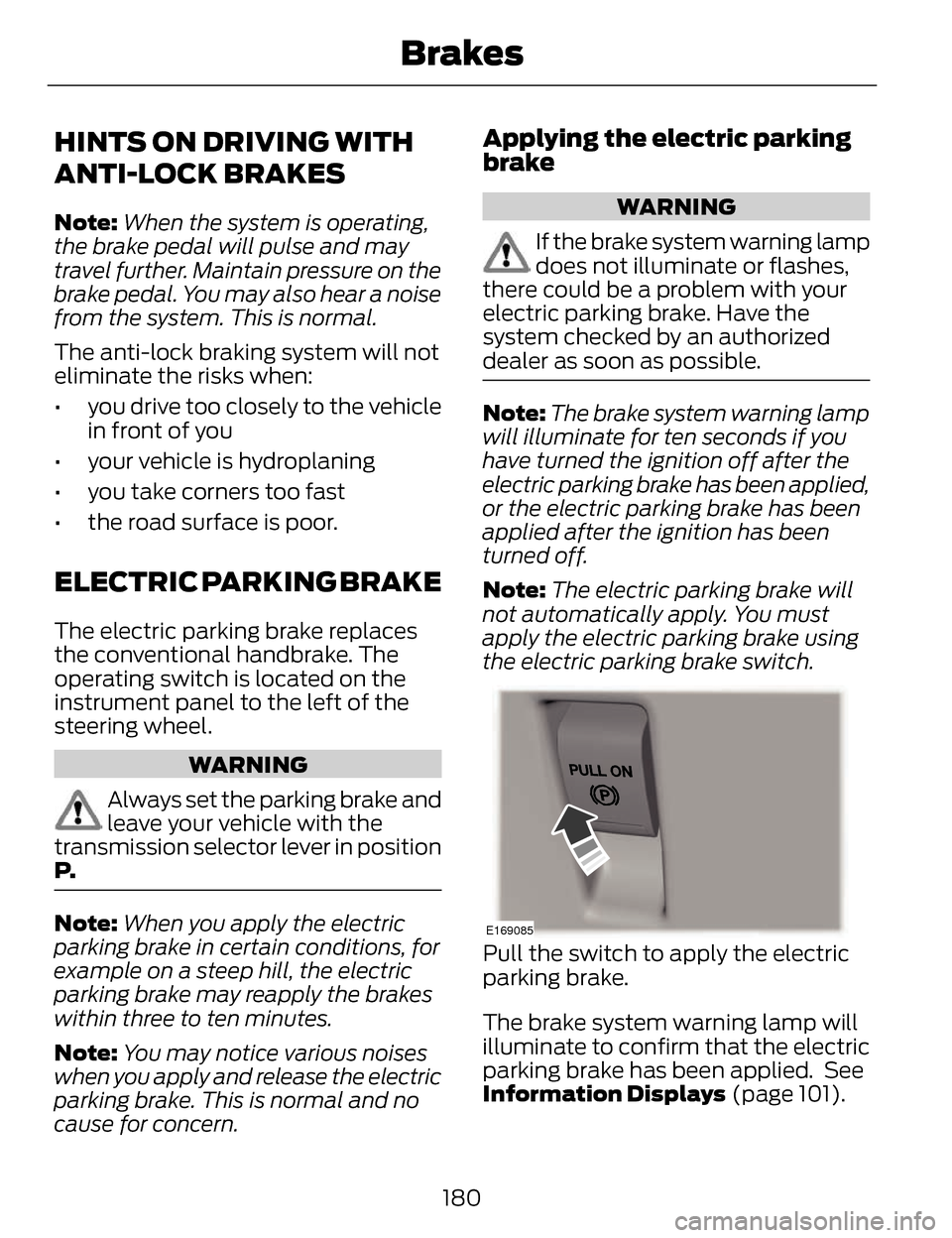
HINTS ON DRIVING WITH
ANTI-LOCK BRAKES
Note:When the system is operating,
the brake pedal will pulse and may
travel further. Maintain pressure on the
brake pedal. You may also hear a noise
from the system. This is normal.
The anti-lock braking system will not
eliminate the risks when:
• you drive too closely to the vehicle in front of you
• your vehicle is hydroplaning
• you take corners too fast
• the road surface is poor.
ELECTRIC PARKING BRAKE
The electric parking brake replaces
the conventional handbrake. The
operating switch is located on the
instrument panel to the left of the
steering wheel.
WARNING
Always set the parking brake and
leave your vehicle with the
transmission selector lever in position
P.
Note: When you apply the electric
parking brake in certain conditions, for
example on a steep hill, the electric
parking brake may reapply the brakes
within three to ten minutes.
Note: You may notice various noises
when you apply and release the electric
parking brake. This is normal and no
cause for concern.
Applying the electric parking
brake
WARNING
If the brake system warning lamp
does not illuminate or flashes,
there could be a problem with your
electric parking brake. Have the
system checked by an authorized
dealer as soon as possible.
Note: The brake system warning lamp
will illuminate for ten seconds if you
have turned the ignition off after the
electric parking brake has been applied,
or the electric parking brake has been
applied after the ignition has been
turned off.
Note: The electric parking brake will
not automatically apply. You must
apply the electric parking brake using
the electric parking brake switch.
E169085
Pull the switch to apply the electric
parking brake.
The brake system warning lamp will
illuminate to confirm that the electric
parking brake has been applied. See
Information Displays (page 101).
180
Brakes
Page 184 of 468
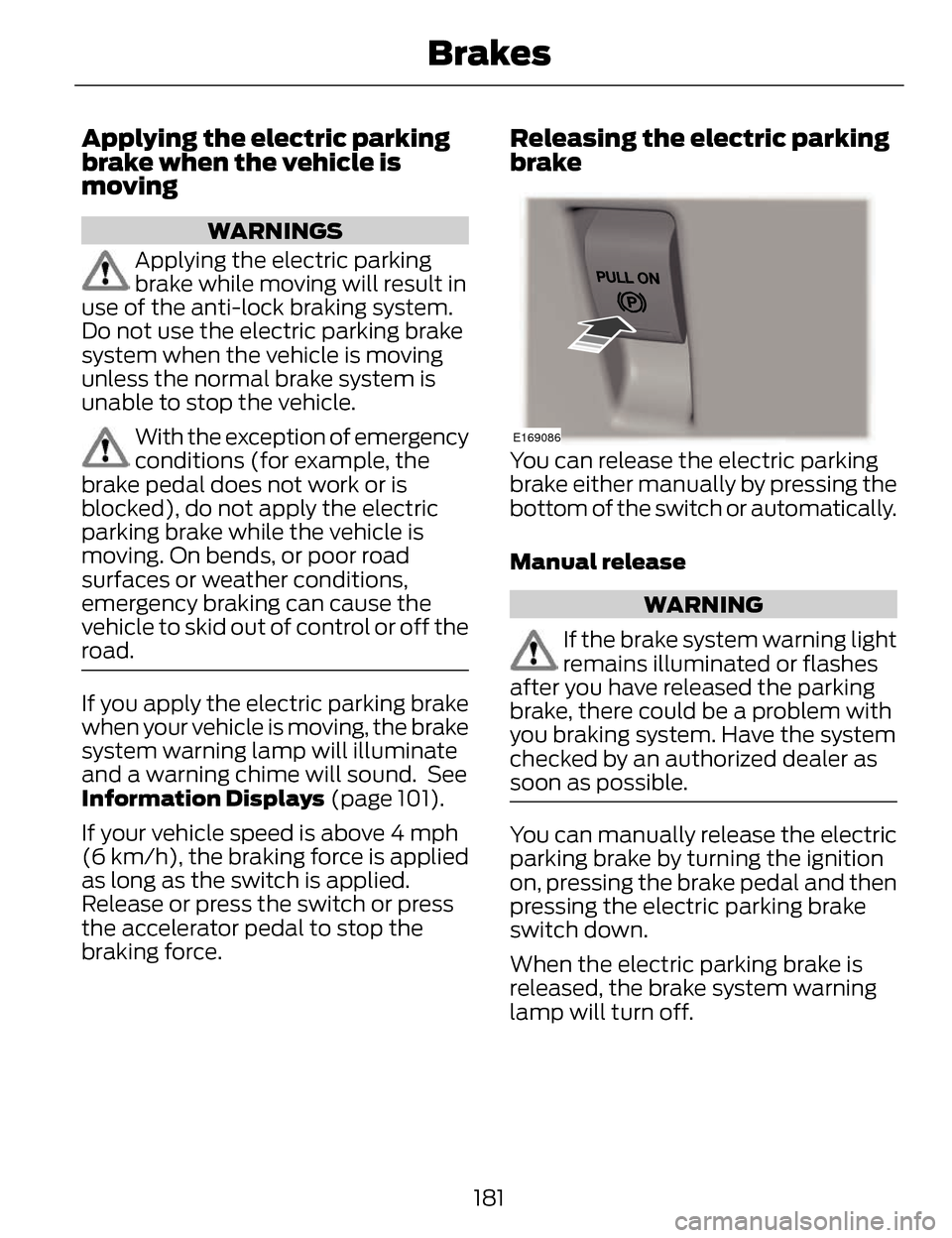
Applying the electric parking
brake when the vehicle is
moving
WARNINGS
Applying the electric parking
brake while moving will result in
use of the anti-lock braking system.
Do not use the electric parking brake
system when the vehicle is moving
unless the normal brake system is
unable to stop the vehicle.
With the exception of emergency
conditions (for example, the
brake pedal does not work or is
blocked), do not apply the electric
parking brake while the vehicle is
moving. On bends, or poor road
surfaces or weather conditions,
emergency braking can cause the
vehicle to skid out of control or off the
road.
If you apply the electric parking brake
when your vehicle is moving, the brake
system warning lamp will illuminate
and a warning chime will sound. See
Information Displays (page 101).
If your vehicle speed is above 4 mph
(6 km/h), the braking force is applied
as long as the switch is applied.
Release or press the switch or press
the accelerator pedal to stop the
braking force.
Releasing the electric parking
brake
E169086
You can release the electric parking
brake either manually by pressing the
bottom of the switch or automatically.
Manual release
WARNING
If the brake system warning light
remains illuminated or flashes
after you have released the parking
brake, there could be a problem with
you braking system. Have the system
checked by an authorized dealer as
soon as possible.
You can manually release the electric
parking brake by turning the ignition
on, pressing the brake pedal and then
pressing the electric parking brake
switch down.
When the electric parking brake is
released, the brake system warning
lamp will turn off.
181
Brakes
Page 187 of 468
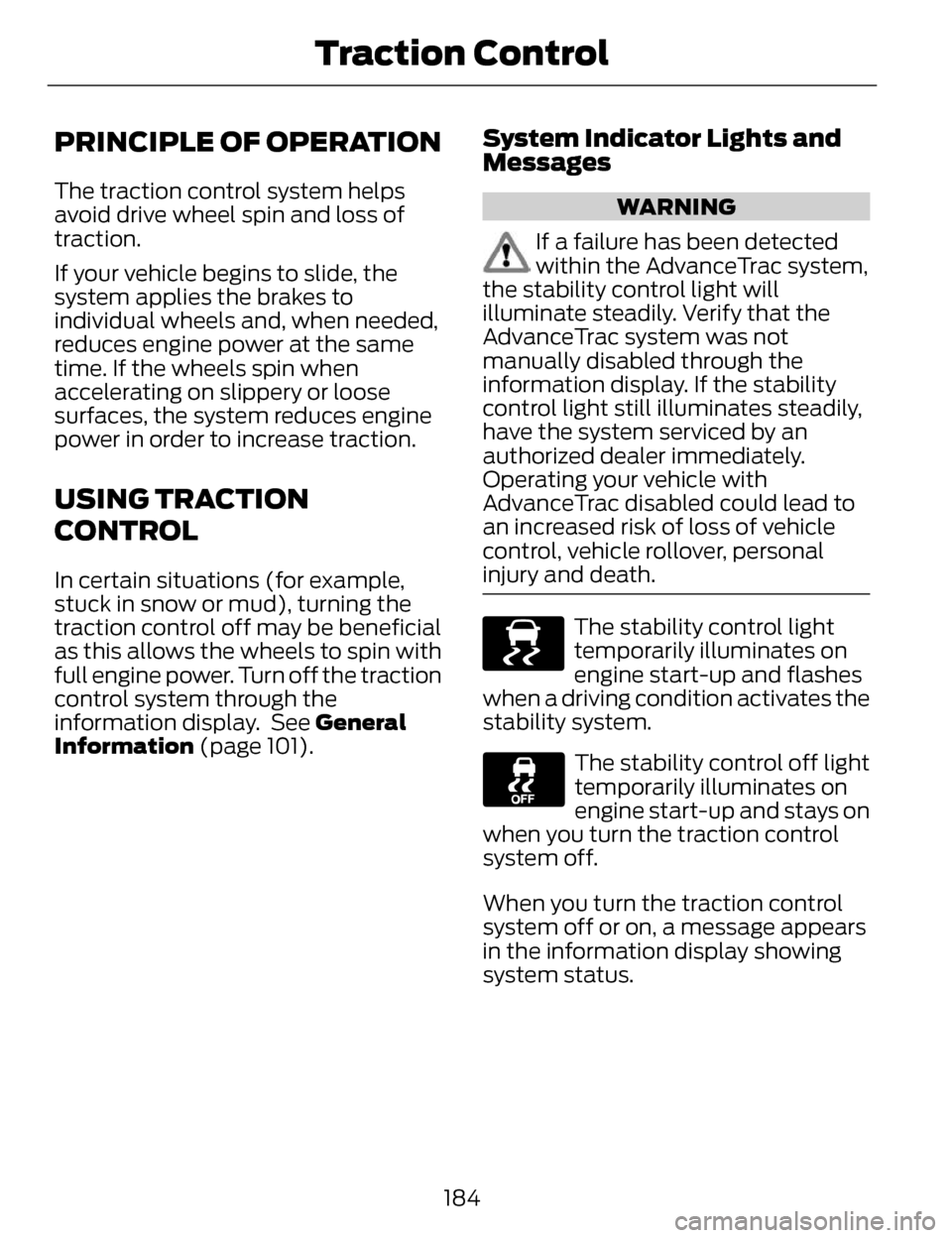
PRINCIPLE OF OPERATION
The traction control system helps
avoid drive wheel spin and loss of
traction.
If your vehicle begins to slide, the
system applies the brakes to
individual wheels and, when needed,
reduces engine power at the same
time. If the wheels spin when
accelerating on slippery or loose
surfaces, the system reduces engine
power in order to increase traction.
USING TRACTION
CONTROL
In certain situations (for example,
stuck in snow or mud), turning the
traction control off may be beneficial
as this allows the wheels to spin with
full engine power. Turn off the traction
control system through the
information display. See General
Information (page 101).
System Indicator Lights and
Messages
WARNING
If a failure has been detected
within the AdvanceTrac system,
the stability control light will
illuminate steadily. Verify that the
AdvanceTrac system was not
manually disabled through the
information display. If the stability
control light still illuminates steadily,
have the system serviced by an
authorized dealer immediately.
Operating your vehicle with
AdvanceTrac disabled could lead to
an increased risk of loss of vehicle
control, vehicle rollover, personal
injury and death.
E138639
The stability control light
temporarily illuminates on
engine start-up and flashes
when a driving condition activates the
stability system.
The stability control off light
temporarily illuminates on
engine start-up and stays on
when you turn the traction control
system off.
When you turn the traction control
system off or on, a message appears
in the information display showing
system status.
184
Traction Control
Page 190 of 468
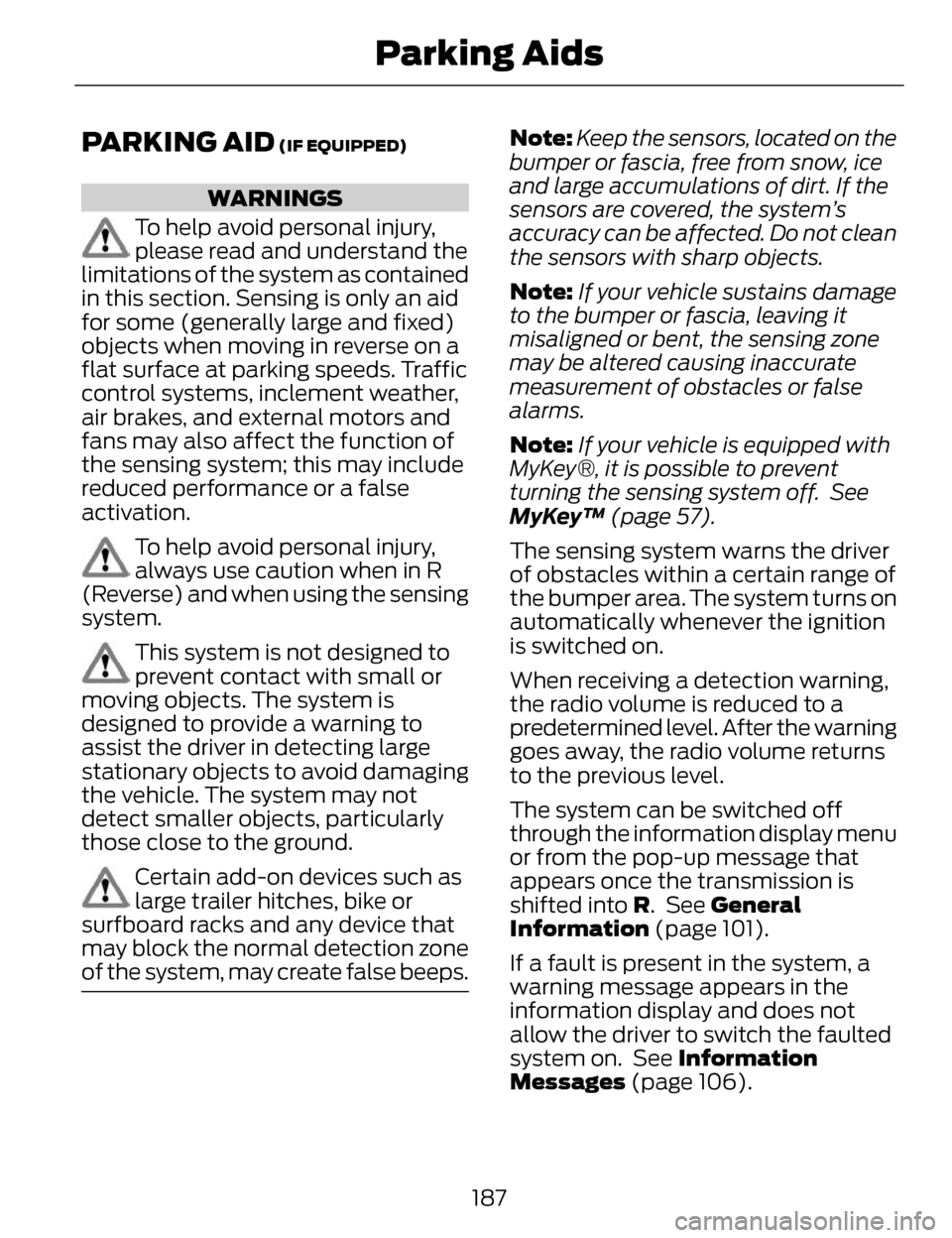
PARKING AID (IF EQUIPPED)
WARNINGS
To help avoid personal injury,
please read and understand the
limitations of the system as contained
in this section. Sensing is only an aid
for some (generally large and fixed)
objects when moving in reverse on a
flat surface at parking speeds. Traffic
control systems, inclement weather,
air brakes, and external motors and
fans may also affect the function of
the sensing system; this may include
reduced performance or a false
activation.
To help avoid personal injury,
always use caution when in R
(Reverse) and when using the sensing
system.
This system is not designed to
prevent contact with small or
moving objects. The system is
designed to provide a warning to
assist the driver in detecting large
stationary objects to avoid damaging
the vehicle. The system may not
detect smaller objects, particularly
those close to the ground.
Certain add-on devices such as
large trailer hitches, bike or
surfboard racks and any device that
may block the normal detection zone
of the system, may create false beeps.
Note: Keep the sensors, located on the
bumper or fascia, free from snow, ice
and large accumulations of dirt. If the
sensors are covered, the system’s
accuracy can be affected. Do not clean
the sensors with sharp objects.
Note: If your vehicle sustains damage
to the bumper or fascia, leaving it
misaligned or bent, the sensing zone
may be altered causing inaccurate
measurement of obstacles or false
alarms.
Note: If your vehicle is equipped with
MyKey®, it is possible to prevent
turning the sensing system off. See
MyKey™ (page 57).
The sensing system warns the driver
of obstacles within a certain range of
the bumper area. The system turns on
automatically whenever the ignition
is switched on.
When receiving a detection warning,
the radio volume is reduced to a
predetermined level. After the warning
goes away, the radio volume returns
to the previous level.
The system can be switched off
through the information display menu
or from the pop-up message that
appears once the transmission is
shifted into R. See General
Information (page 101).
If a fault is present in the system, a
warning message appears in the
information display and does not
allow the driver to switch the faulted
system on. See Information
Messages (page 106).
187
Parking Aids
Page 193 of 468
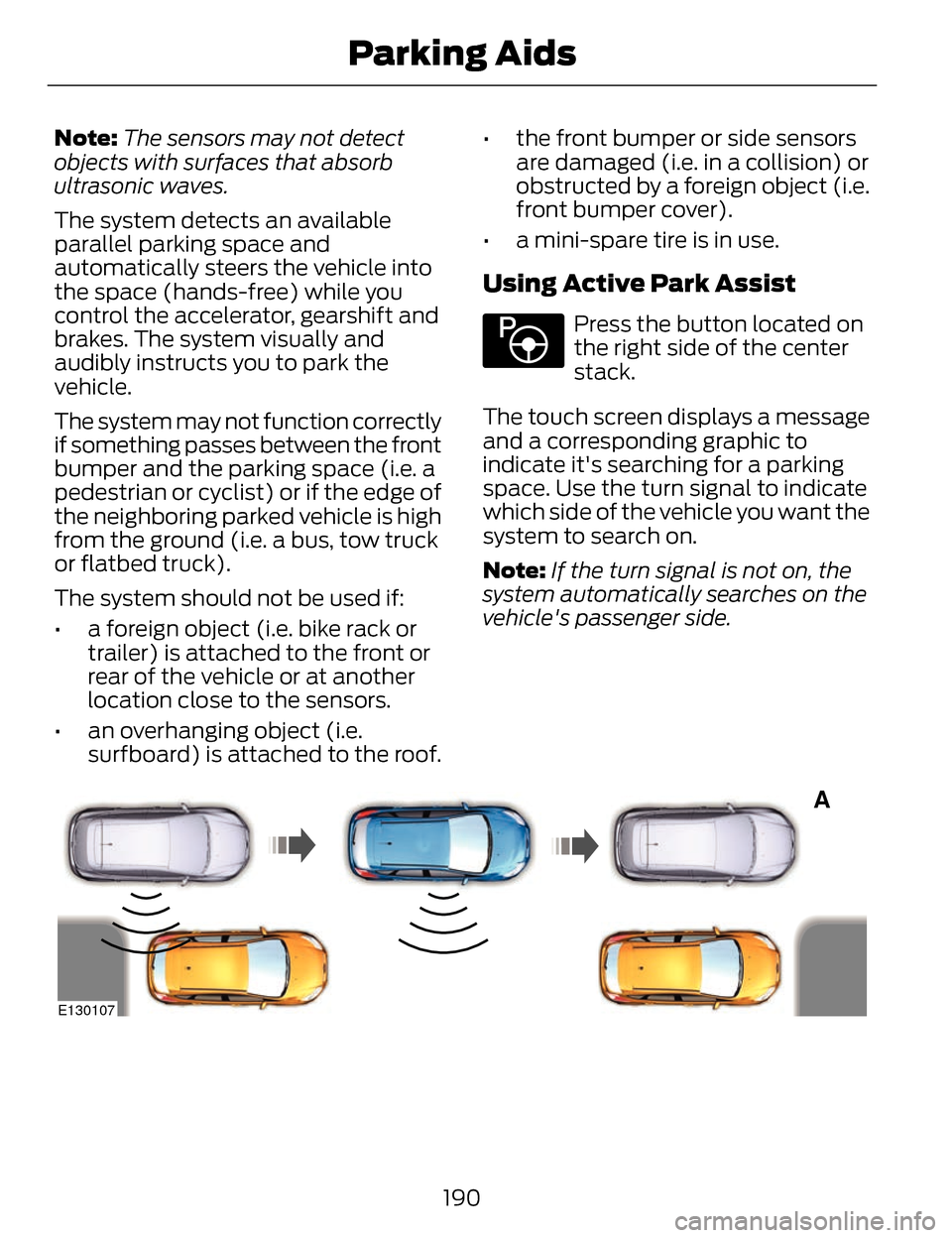
Note:The sensors may not detect
objects with surfaces that absorb
ultrasonic waves.
The system detects an available
parallel parking space and
automatically steers the vehicle into
the space (hands-free) while you
control the accelerator, gearshift and
brakes. The system visually and
audibly instructs you to park the
vehicle.
The system may not function correctly
if something passes between the front
bumper and the parking space (i.e. a
pedestrian or cyclist) or if the edge of
the neighboring parked vehicle is high
from the ground (i.e. a bus, tow truck
or flatbed truck).
The system should not be used if:
• a foreign object (i.e. bike rack or trailer) is attached to the front or
rear of the vehicle or at another
location close to the sensors.
• an overhanging object (i.e. surfboard) is attached to the roof. • the front bumper or side sensors
are damaged (i.e. in a collision) or
obstructed by a foreign object (i.e.
front bumper cover).
• a mini-spare tire is in use.
Using Active Park Assist
E146186
Press the button located on
the right side of the center
stack.
The touch screen displays a message
and a corresponding graphic to
indicate it's searching for a parking
space. Use the turn signal to indicate
which side of the vehicle you want the
system to search on.
Note: If the turn signal is not on, the
system automatically searches on the
vehicle's passenger side.
A
E130107
190
Parking Aids
Page 194 of 468
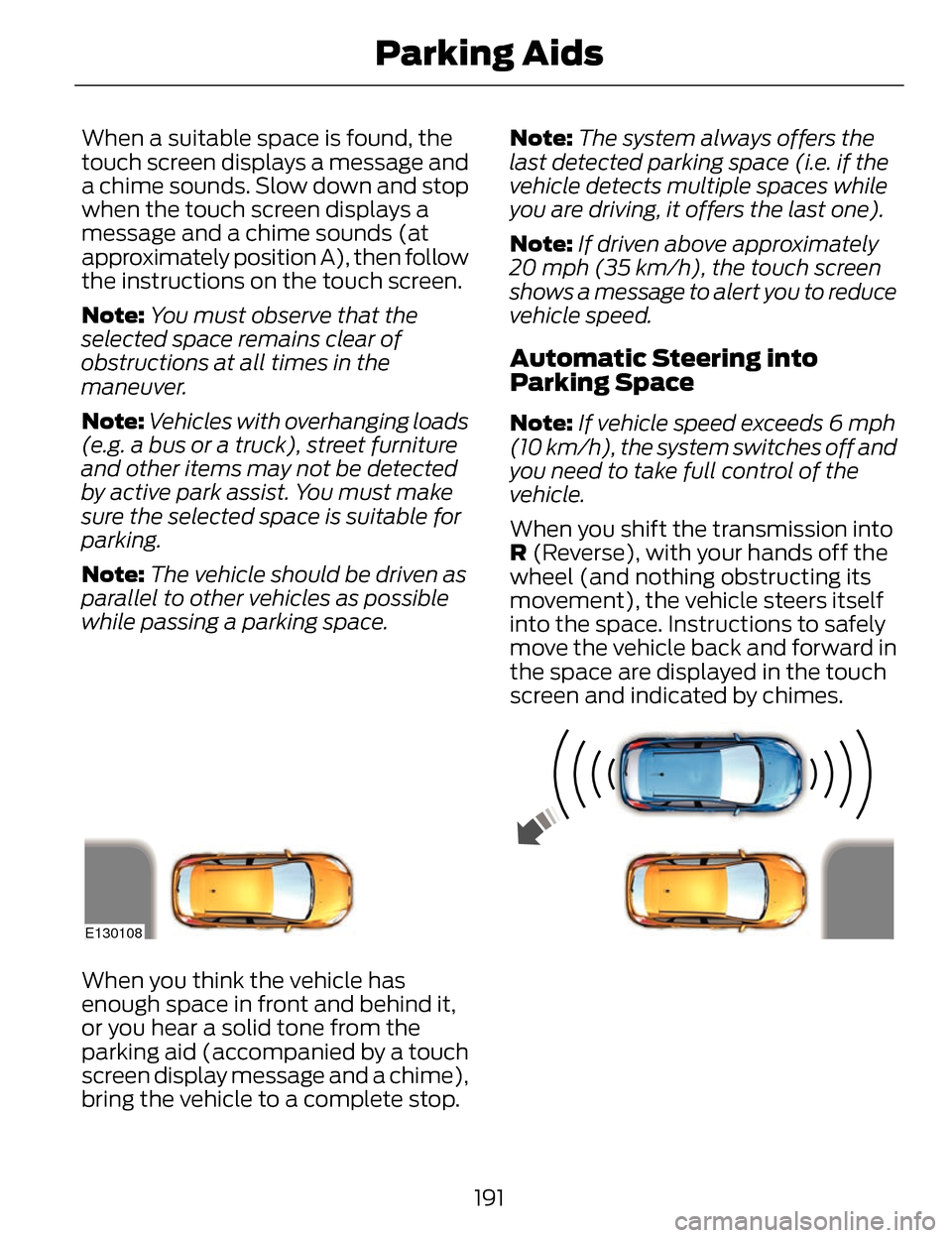
When a suitable space is found, the
touch screen displays a message and
a chime sounds. Slow down and stop
when the touch screen displays a
message and a chime sounds (at
approximately position A), then follow
the instructions on the touch screen.
Note:You must observe that the
selected space remains clear of
obstructions at all times in the
maneuver.
Note: Vehicles with overhanging loads
(e.g. a bus or a truck), street furniture
and other items may not be detected
by active park assist. You must make
sure the selected space is suitable for
parking.
Note: The vehicle should be driven as
parallel to other vehicles as possible
while passing a parking space. Note:
The system always offers the
last detected parking space (i.e. if the
vehicle detects multiple spaces while
you are driving, it offers the last one).
Note: If driven above approximately
20 mph (35 km/h), the touch screen
shows a message to alert you to reduce
vehicle speed.
Automatic Steering into
Parking Space
Note: If vehicle speed exceeds 6 mph
(10 km/h), the system switches off and
you need to take full control of the
vehicle.
When you shift the transmission into
R (Reverse), with your hands off the
wheel (and nothing obstructing its
movement), the vehicle steers itself
into the space. Instructions to safely
move the vehicle back and forward in
the space are displayed in the touch
screen and indicated by chimes.
E130108
When you think the vehicle has
enough space in front and behind it,
or you hear a solid tone from the
parking aid (accompanied by a touch
screen display message and a chime),
bring the vehicle to a complete stop.
191
Parking Aids
Page 195 of 468
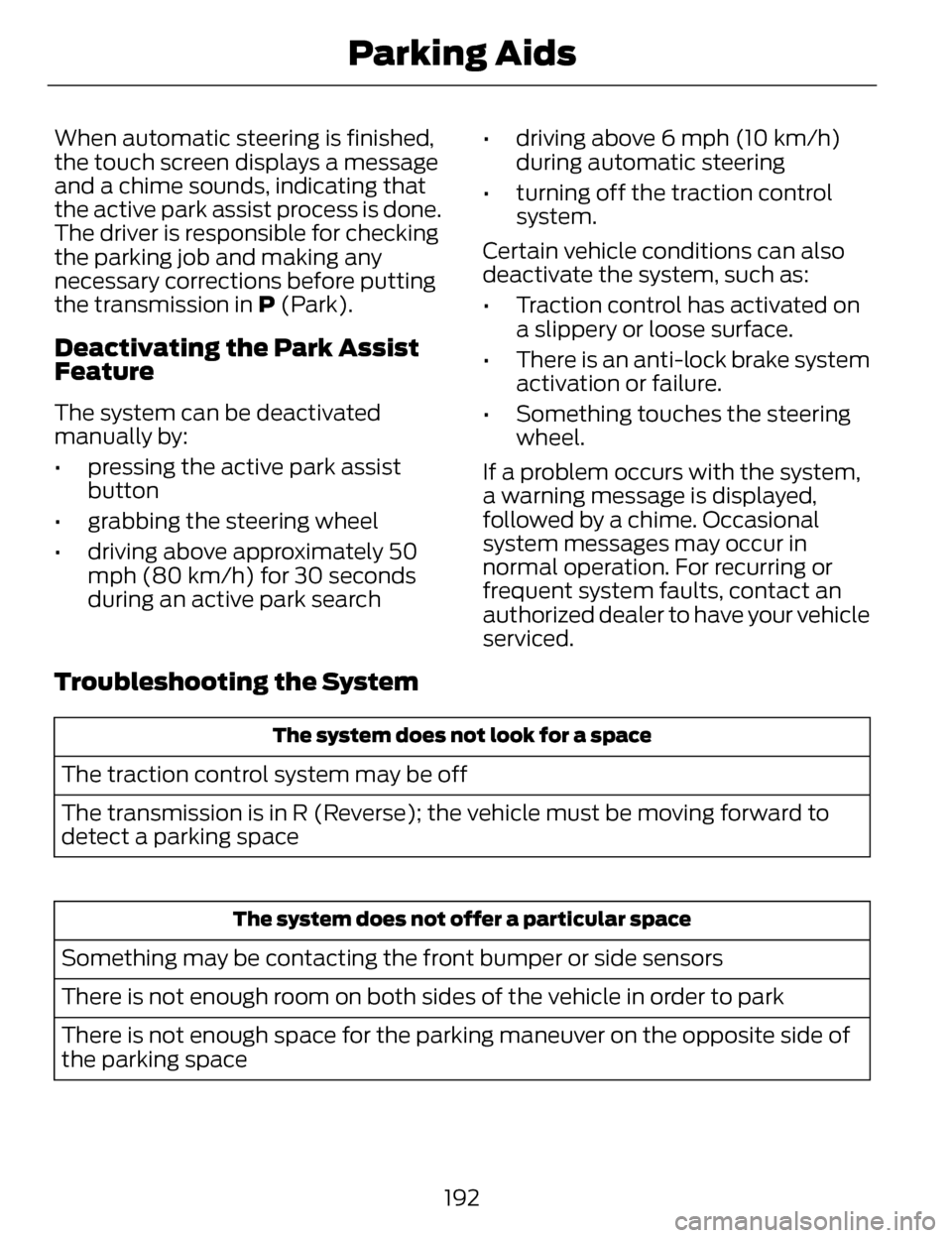
When automatic steering is finished,
the touch screen displays a message
and a chime sounds, indicating that
the active park assist process is done.
The driver is responsible for checking
the parking job and making any
necessary corrections before putting
the transmission in P (Park).
Deactivating the Park Assist
Feature
The system can be deactivated
manually by:
• pressing the active park assistbutton
• grabbing the steering wheel
• driving above approximately 50 mph (80 km/h) for 30 seconds
during an active park search • driving above 6 mph (10 km/h)
during automatic steering
• turning off the traction control system.
Certain vehicle conditions can also
deactivate the system, such as:
• Traction control has activated on a slippery or loose surface.
• There is an anti-lock brake system activation or failure.
• Something touches the steering wheel.
If a problem occurs with the system,
a warning message is displayed,
followed by a chime. Occasional
system messages may occur in
normal operation. For recurring or
frequent system faults, contact an
authorized dealer to have your vehicle
serviced.
Troubleshooting the System
The system does not look for a space
The traction control system may be off
The transmission is in R (Reverse); the vehicle must be moving forward to
detect a parking space
The system does not offer a particular space
Something may be contacting the front bumper or side sensors
There is not enough room on both sides of the vehicle in order to park
There is not enough space for the parking maneuver on the opposite side of
the parking space
192
Parking Aids